![]()
It seems the only teams that can beat the Pittsburgh Penguins are Western Conference bottom-feeders. The Penguins own the best record in hockey since Dec. 19, with a 10-2-0 mark in 12 games, including an eight-game winning streak. Their only two losses occurred against the Chicago Blackhawks (Jan. 6) and Los Angeles Kings (Jan. 12) who are 28th and 29th in league standings, respectively. The good news for the Penguins is that they don’t play either team again this season, so it should be smooth sailing from here.
Outside of their setbacks against the Blackhawks and Kings, the Penguins have generally been at their best over the last month, a big turnaround from their dreadful month of November when they won just four games. Their recent run of success has vaulted them from outside a playoff spot to third place in the Metropolitan Division.
The Penguins, led by two goals from Bryan Rust and Matt Murray’s 36 saves, started the week with a 5-1 victory over the Florida Panthers on Tuesday night in what was their final home game before the All-Star break. They started their five-game western road trip on Friday night with a 7-4 victory against the Anaheim Ducks, led by Jake Guentzel’s hat trick, and their week concluded with a 5-2 loss against the Kings on Saturday night as Jonathan Quick stopped 38 of 40 shots to deny the Penguins a chance at a perfect week.
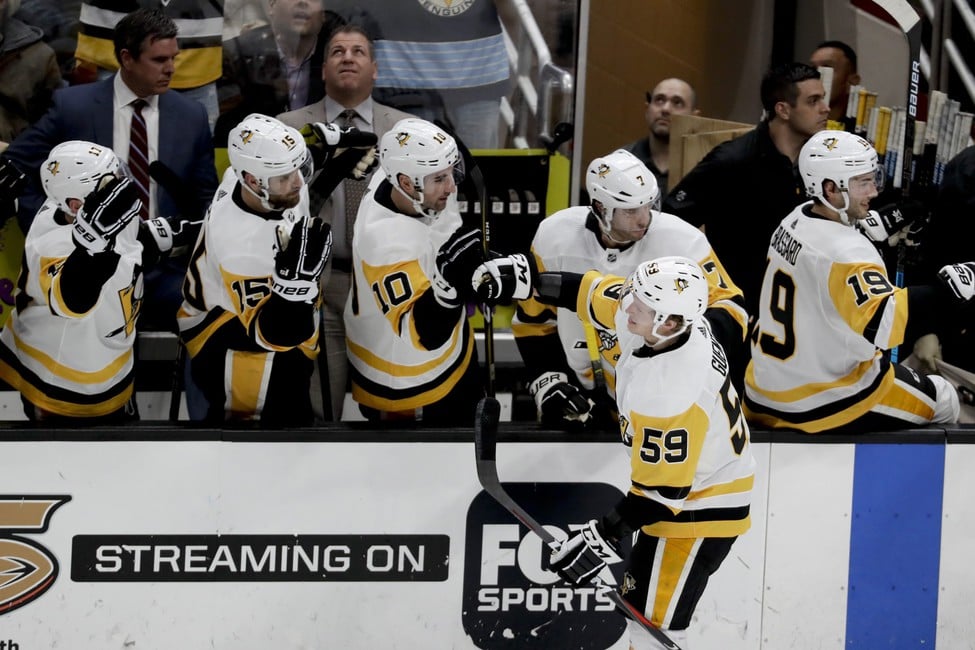
In this week’s Penguins Pulpit, we look at the impact of the injuries suffered by Patric Hornqvist and Zach Aston-Reese on Tuesday night, Casey DeSmith’s new contract extension and what it means for Tristan Jarry, and if the Penguins need to think about acquiring a new third-line center as the trade deadline draws closer.
2018-19 Record: 25-14-6, 56 points (3rd in Metropolitan Division, 6th in Eastern Conference, 11th in League Standings)
Hornqvist, Aston-Reese Both Injured on Tuesday
Naturally, the Penguins can’t escape a run of success without something bad happening to them. Head coach Mike Sullivan announced on Thursday that Hornqvist and Aston-Reese would both be out of the lineup due to injuries suffered during Tuesday’s game against the Panthers. Hornqvist is day-to-day with a concussion and Aston-Reese is out “longer-term” due to an upper-body injury.
Hornqvist, the bigger name of the two, was hit in the face by a puck in the first period of Tuesday’s game and didn’t return. At that point, it was apparent he was dealing with something serious because it takes more than a cut to keep the 32-year-old off the ice, though it was a shock when Sullivan announced he had suffered a concussion. It’s the second one Hornqvist’s suffered in the last two months and his fifth documented one since the 2014-15 season, which is a worrying number for a player with his style of play.
His forte is being a pest in front of the net, making goalies lives miserable and getting into the thick of everything physical, which means he’s going to take a high volume of sticks, pucks and hits to all regions of his body, especially his head. It’s going to continue to become a growing concern as Hornqvist ages.

Of course as is the case with every concussion, there’s no timetable for Hornqvist’s return, but some good news arose on Saturday when the Penguins announced he had been skating for the last few days, albeit with no contact. While the Penguins will be cautious with him, they’re certainly hoping for a speedy recovery as he has 25 points (15 goals, 10 assists) in 33 games this season and is a vital piece of the top power-play unit.
As for Aston-Reese, the news hasn’t been as favorable for him. While the Penguins won’t disclose what his upper-body injury is, it’s assumed to be a hand injury suffered during his scrap with Colton Sceviour in the third period of Tuesday’s game. It’s an unfortunate turn of events for the 24-year-old as he looked to be playing the best hockey of his young career and had been a critical component in making the Penguins’ fourth line relevant again. In 30 games this season, he has six goals and five assists for 11 points.
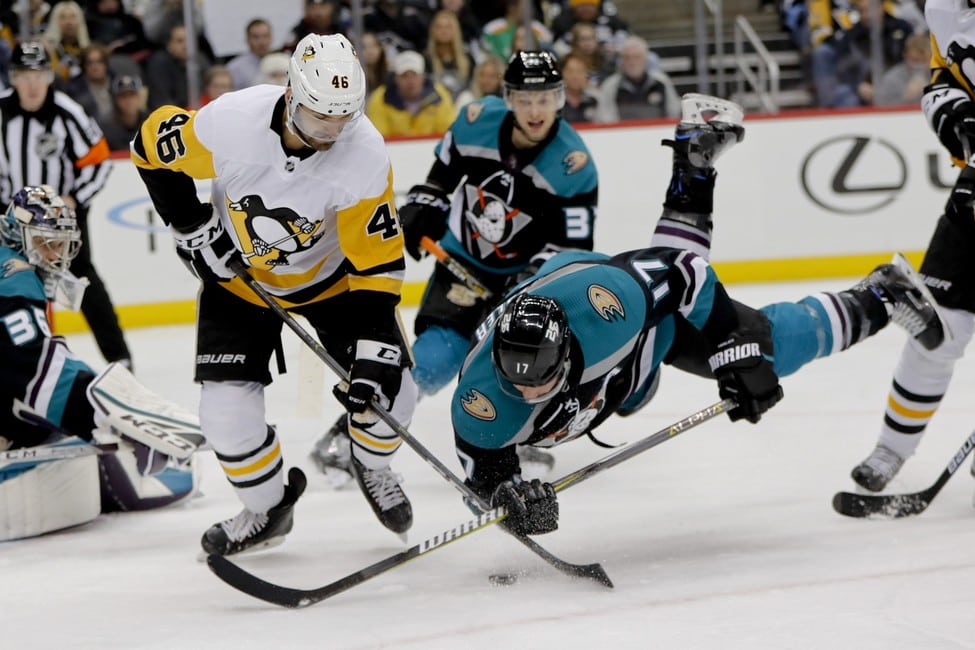
Aston-Reese’s absence also causes a problem for the Penguins because his replacement, Garrett Wilson, doesn’t bring the mix of physicality and scoring ability that Aston-Reese does, thus hindering any offensive success the fourth line may have. The concern for him is if the injury will hurt his performance even when he returns, as hands are essential for a hockey player.
The good news, of course, is that he can still skate and stay in shape while he recovers, making it likely he won’t need practice time to return to the lineup. If the “longer-term” tag for him works out the same way it did for Murray earlier this season, he will likely be back around mid-February, but until then the Penguins are going to have to make do with a bottom line of Wilson, Matt Cullen and Riley Sheahan.
Related: Aston-Reese a Key to Penguins Recent Success
It was a rough week on the injury front for a team who’s generally gotten lucky this season, but like all good teams, the Penguins are going to have to overcome a few injuries along the way if they want to remain in contention.
DeSmith’s Extension and What It Means for Tristan Jarry
In case you missed it, the Penguins signed DeSmith to a three-year, $3.75 million contract extension on Friday afternoon. DeSmith, who’s in the last year of a two-year, $1.3 million deal he signed in July 2017, is now signed through the 2021-22 season. It’s a well-deserved deal for the 27-year-old as he holds a 12-8-4 record, a .921 save percentage (SV%), a 2.53 goals-against average (GAA) and two shutouts in 27 games (23 starts) this season. In his career, he has a .921 SV%, 2.49 GAA, and three shutouts in 41 games.
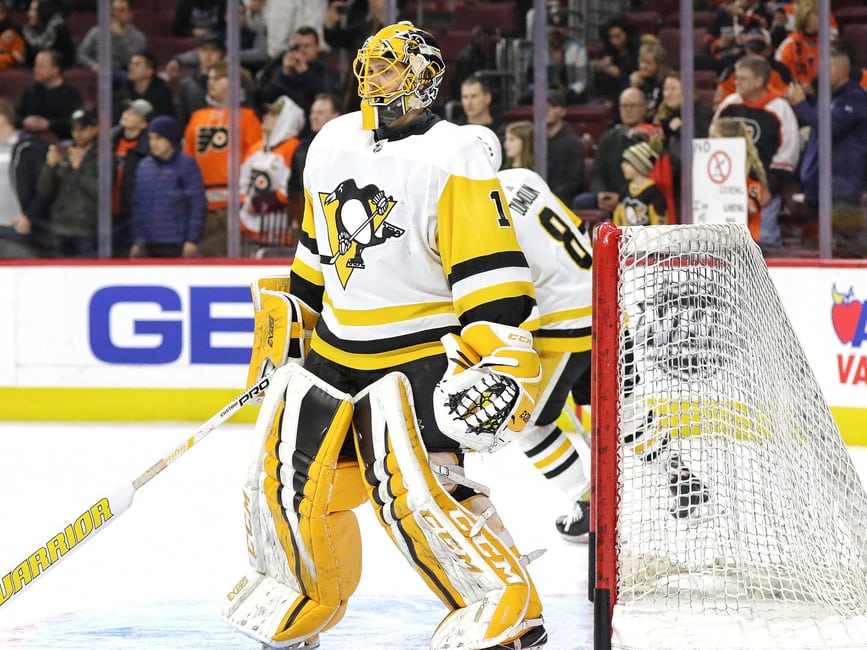
While the numbers are solid, DeSmith earned his extension for more than one reason. He kept the Penguins afloat with his strong performance in net while Murray dealt with injuries and poor play earlier this season and allowed the Penguins to climb back into a playoff spot once their play turned a corner.
Another reason why he earned the trust of Penguins’ brass after just 41 NHL games stems from his success everywhere he’s played. At the University of New Hampshire, he posted a .923 SV% in 97 games, with the Wheeling Nailers of the ECHL, he posted a .915 SV% in 13 games and a .918 mark in 62 games with the Wilkes-Barre/Scranton Penguins of the AHL, along with his .921 SV% in his NHL career.
There are some negatives to his game and DeSmith is far from the perfect goalie. His positioning is sub-par, as are his angles. It gives shooters more space to work with and it leads to many goals he should stop. The other fault to his game is a habit of allowing goals in low-danger situations. Nobody is going to blame you for deflections in front of the net, but when slapshots from the point seem to beat you at least once a start, it becomes a talking point. Regardless, he gets the job done, and whenever you expect him to regress, he comes back with a 30-save performance and gives the Penguins a chance to win.
While everyone in the Penguins organization will be happy to have DeSmith around for another three seasons, it means another goalie, Tristan Jarry, has limited time left with the organization.
Selected with the 44th overall pick in the 2013 Entry Draft, Jarry was expected to be a mainstay in the Penguins’ crease in the future. Now almost six years after being drafted, he’s played just 29 NHL games while posting middling results and hasn’t shown much improvement in the AHL after a breakout 2016-17 season when he posted a .925 SV% in 45 games.

Jarry has spent some time with the Penguins this season, posting a .887 SV% in two starts, but has spent a majority of his time with Wilkes-Barre/Scranton, going 11-7-1 with a .910 SV%, a 2.77 GAA and a goal of his own in 21 games.
GOALIE GOAL! Tristan Jarry finds the empty net for the #WBSPens – #WBS20 pic.twitter.com/gXU4d3ROkd
— WBS Penguins (@WBSPenguins) November 14, 2018
Now, the Penguins don’t necessarily have to trade Jarry for the sake of moving him, but it would be poor asset management to hold onto him when he isn’t going to take the jobs of Murray or DeSmith, and his value continues to plummet as he ages. He isn’t going to have much trade value and will be an add-on rather than a centerpiece to any deal Jim Rutherford makes before the trade deadline.
The reason being he doesn’t have much of a resume at the professional level — .913 SV% in the AHL, and .906 SV% in the NHL — will be 24 in April, hasn’t shown a ton of improvement since making the jump to the pro level and teams don’t value young goalies the same way as skaters.
You may be asking, if teams don’t value goalies, then why was Filip Gustavsson, the Penguins’ 2016 second-round pick, the centerpiece of last season’s trade for Derick Brassard? Their situations are different. At the time, Gustavsson was 19 years old and 20 months removed from being drafted, was named the best goalie at the World Juniors a month earlier and had spent most of his time since his 17th birthday playing against men in Sweden.
Even then, the Penguins had to include a first and third-round picks and Ian Cole to get the deal done, so Jarry isn’t going to fetch anything significant by himself. That said, he is still a talented goalie and has the potential to succeed at the NHL level, but he’s struggled to put it together and it’s ultimately why the Penguins are confident in going forward with DeSmith as Murray’s backup for the long run.
New Third-Line Center? Things Could Get Challenging
With six weeks to go until the Feb. 25 trade deadline, there are still some questions surrounding what the Penguins will do. Will they make a move for a top-six player, a third-line center or stand pat and hope their current roster will be enough to win a Stanley Cup?
Right now their focus should be on if Brassard is the right guy to lead the third line into the playoffs or not. He’s a good player with a lot to offer, but he just hasn’t fit in on the ice, and they’ll need to consider a move.
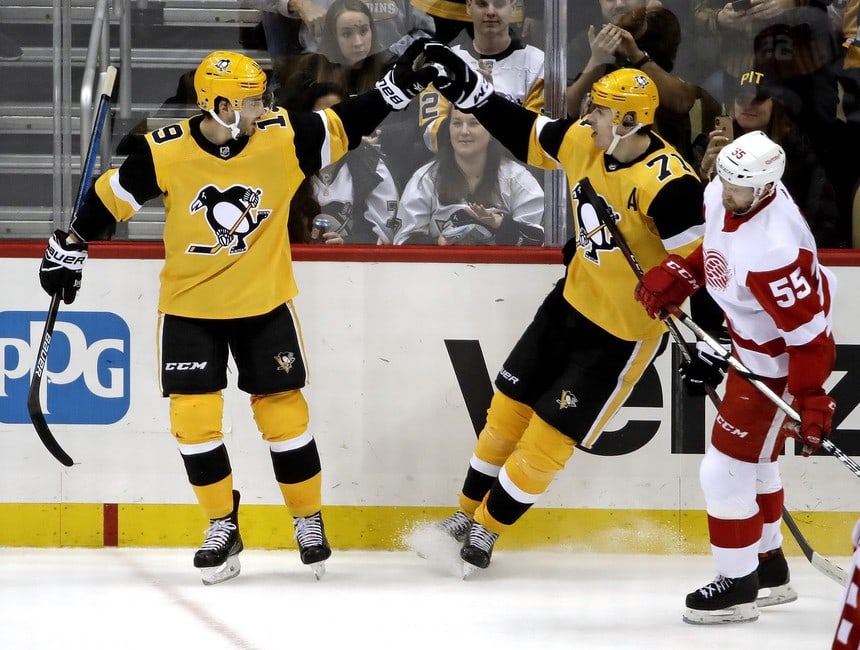
When Brassard was acquired in Feb. 2018, it looked like one of Rutherford’s best moves, at least on paper. They were getting the best third-line center, a guy who’d center most teams’ second lines, that they’ve had in the era of Malkin and Crosby, but it just hasn’t worked out the way the Penguins had envisioned.
In 50 games with the club, he has 21 points — 10 goals, 11 assists — and has rarely looked good in any of those 50 contests, nor has he seemed to build chemistry with anybody in the top-nine. He has shown small improvements since the Christmas break, but it may not be enough to convince Rutherford to stay away from exploring the market for a new third-line pivot.
Yes, Brassard is a proven playoff performer with 59 points in 90 games, but his struggles since coming to Pittsburgh have to be worrying. Crosby, Malkin, Phil Kessel and Kris Letang aren’t getting younger, and the Penguins can ill-afford to waste a season of their shrinking championship window hoping Brassard suddenly shows up in the playoffs if he continues to struggle leading up to them. However, if the team decides to seek out a replacement, they’re faced with a challenge.
The list of centers better than Brassard who will likely be available is short: Matt Duchene, Kevin Hayes and Brayden Schenn. All of them are young — Duchene will be 28 on Wednesday, Hayes is 26 and Schenn is 27 — and none are natural third liners. In Duchene and Schenn’s cases, they’re first line players, while Hayes is a second liner. It’s not going to be cheap to acquire any of the three, and even if the Penguins include Brassard and Jarry in any potential deal, they’re still going to be many assets short.
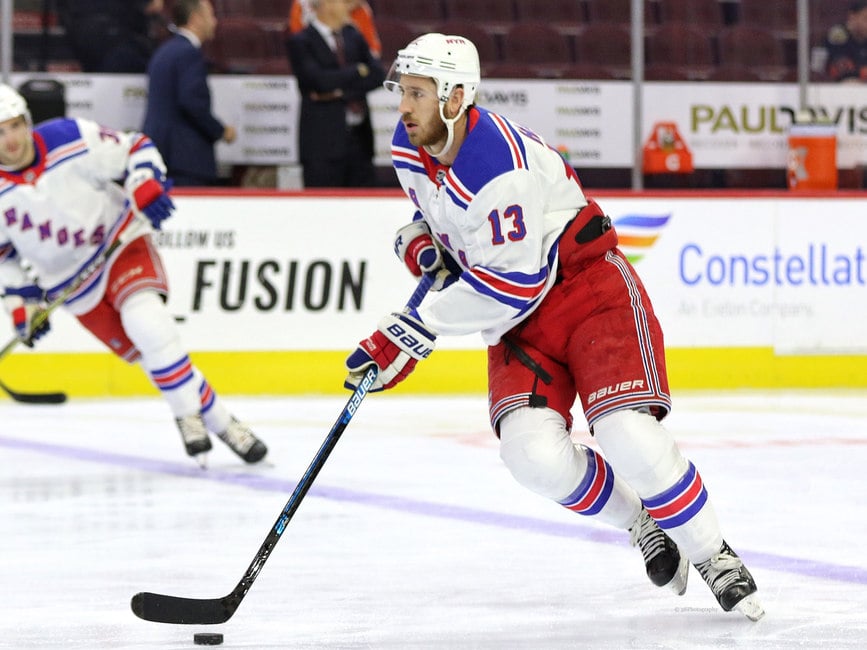
Another issue is, like Brassard, these players would be sliding into unfamiliar territory if acquired. Just because a player is a first-line or second-line talent doesn’t mean they’re going to excel in a more relaxed role. If the Penguins go out and get one of those players, they need to be confident it won’t be a repeat of the move they made less than a year ago. Sending multiple assets to the Ottawa Senators, New York Rangers or St. Louis Blues and whiffing on it could hurt their ability to make future trades as they attempt to squeeze another Stanley Cup out of their once-in-a-generation core.
As the Penguins head into their final three games before their bye week and the All-Star break, they’ll be hoping to come out of it with a healthy lineup, clarity on what to do with Jarry and plans on how to proceed to the trade deadline.
What’s Up Next:
1/15/19: @ San Jose Sharks
1/18/19: @ Arizona Coyotes
1/19/19: @ Vegas Golden Knights
Leading scorer of the week: Jake Guentzel, six points (five goals, one assist)
Three Stars of the Week:
- Jake Guentzel: six points, one hat trick
- Evgeni Malkin: six points
- Phil Kessel: four points, game-winning goal